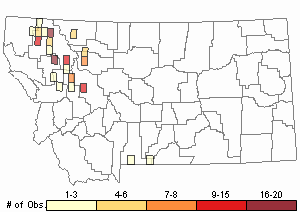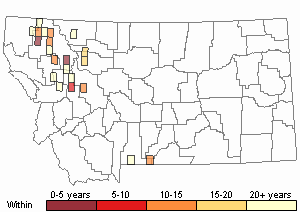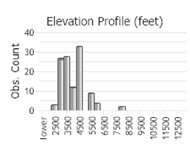View in other NatureServe Network Field Guides
NatureServe
Montana
Utah
Wyoming
Idaho
Wisconsin
British Columbia
South Carolina
Yukon
California
New York
Pale Sedge - Carex livida
Native Species
Global Rank:
G5
State Rank:
S4
C-value:
9
Agency Status
USFWS:
USFS:
BLM:
External Links
General Description
Long-rhizomatous. Stems erect, 10–40 cm. Leaves pale green, basal and lower-cauline; blades 1–4 mm wide. Inflorescence of 2 or 3 well-separated spikes; the lowest bract longer or shorter than the inflorescence. Spikes unisexual; the uppermost male, narrow, 7–20 mm long; the lower female, ascending, short-pedunculate, 1–2 cm long, cylindric. Perigynia ascending, pale green, narrowly elliptic, glabrous, glaucous, 2–3.5 mm long, beakless, tapered at both ends; stigmas 3. Female scales tan to brown with a green midstripe, ca. as long as the perigynia. Achene 3-sided, nearly filling the perigynium (
Lesica et al. 2012. Manual of Montana Vascular Plants. BRIT Press. Fort Worth, TX).
Phenology
Fruit mature in late June-early August.
Diagnostic Characteristics
Carex is a very large genus, making it sometimes difficult to identify individual species. Specimens with mature fruit are necessary for positive identification. Carex livida has a distinctly pale, waxy appearance to the foliage in the field, and a densely bumpy surface on the perigynium that is diagnostic. A hand lens or microscope and technical key are needed for positive identification. In its habitat of calcareous fens, C. livida is best distinguished by its relatively short stature and glaucous foliage.
Species Range
Montana Range
Range Descriptions

 Native
Native
Range Comments
Circumboreal south to CA, WY, IN and NY (Lesica et al. 2012. Manual of Montana Vascular Plants. BRIT Press. Fort Worth, TX).
Observations in Montana Natural Heritage Program Database
Number of Observations: 125
(Click on the following maps and charts to see full sized version)
Map Help and Descriptions
Relative Density

Recency



 (Observations spanning multiple months or years are excluded from time charts)
(Observations spanning multiple months or years are excluded from time charts)
Habitat
Wet, organic soils of fens in the foothill and montane zones.
National Vegetation Classification System Groups Associated with this Species
Wetland and Riparian
Peatland
Stewardship Responsibility
References
- Literature Cited AboveLegend:
 View Online Publication
View Online Publication Lesica, P., M.T. Lavin, and P.F. Stickney. 2012. Manual of Montana Vascular Plants. Fort Worth, TX: BRIT Press. viii + 771 p.
Lesica, P., M.T. Lavin, and P.F. Stickney. 2012. Manual of Montana Vascular Plants. Fort Worth, TX: BRIT Press. viii + 771 p.
- Additional ReferencesLegend:
 View Online Publication
View Online Publication
Do you know of a citation we're missing? Caicco, S. L. 1987. Field investigations of selected sensitive plant species on the Idaho Panhandle National Forest. Idaho Natural Heritage Program, Idaho Department of Fish and Game, Boise, Idaho. 44 pp.
Caicco, S. L. 1987. Field investigations of selected sensitive plant species on the Idaho Panhandle National Forest. Idaho Natural Heritage Program, Idaho Department of Fish and Game, Boise, Idaho. 44 pp. Cooper, D. J. 1991. Additions to the peatland flora of the southern Rocky Mountains: habitat description and water chemistry. Madrono 38(2): 139-143.
Cooper, D. J. 1991. Additions to the peatland flora of the southern Rocky Mountains: habitat description and water chemistry. Madrono 38(2): 139-143. Fertig, W. and G. Jones. 1992. Plant communities and rare plant species of the Swamp Lake Botanical Area, Clark's Fork Ranger District, Shoshone National Forest. Unpublished report to the Shoshone National Forest. Challenge Cost Share Agreement No. CSA-2-91-14-0001. Wyoming Natural Diversity Database. 113+ pp.
Fertig, W. and G. Jones. 1992. Plant communities and rare plant species of the Swamp Lake Botanical Area, Clark's Fork Ranger District, Shoshone National Forest. Unpublished report to the Shoshone National Forest. Challenge Cost Share Agreement No. CSA-2-91-14-0001. Wyoming Natural Diversity Database. 113+ pp. Hermann, F. J. 1970. Manual of the Carices of the Rocky Mountains and Colorado Basin. Agricultural Handbook No. 374. USDA Forest Service. 397 pp.
Hermann, F. J. 1970. Manual of the Carices of the Rocky Mountains and Colorado Basin. Agricultural Handbook No. 374. USDA Forest Service. 397 pp. Lesica, P. 1986. Vegetation and flora of Pine Butte fen, Teton County, Montana. The Great Basin Naturalist 46(1): 22-32.
Lesica, P. 1986. Vegetation and flora of Pine Butte fen, Teton County, Montana. The Great Basin Naturalist 46(1): 22-32. Lesica, P. 1991. The Rare Vascular Plants of Pine Butte Swamp Preserve. Unpublished Report to the Nature Conservancy. 15 Pp.
Lesica, P. 1991. The Rare Vascular Plants of Pine Butte Swamp Preserve. Unpublished Report to the Nature Conservancy. 15 Pp. Lesica, P., M.T. Lavin, and P.F. Stickney. 2022. Manual of Montana Vascular Plants, Second Edition. Fort Worth, TX: BRIT Press. viii + 779 p.
Lesica, P., M.T. Lavin, and P.F. Stickney. 2022. Manual of Montana Vascular Plants, Second Edition. Fort Worth, TX: BRIT Press. viii + 779 p. Mattson, D.J. 1984. Classification and environmental relationships of wetland vegetation in central Yellowstone National Park. M.Sc. Thesis. Moscow, ID: University of Idaho. 503 p.
Mattson, D.J. 1984. Classification and environmental relationships of wetland vegetation in central Yellowstone National Park. M.Sc. Thesis. Moscow, ID: University of Idaho. 503 p.
- Web Search Engines for Articles on "Pale Sedge"





